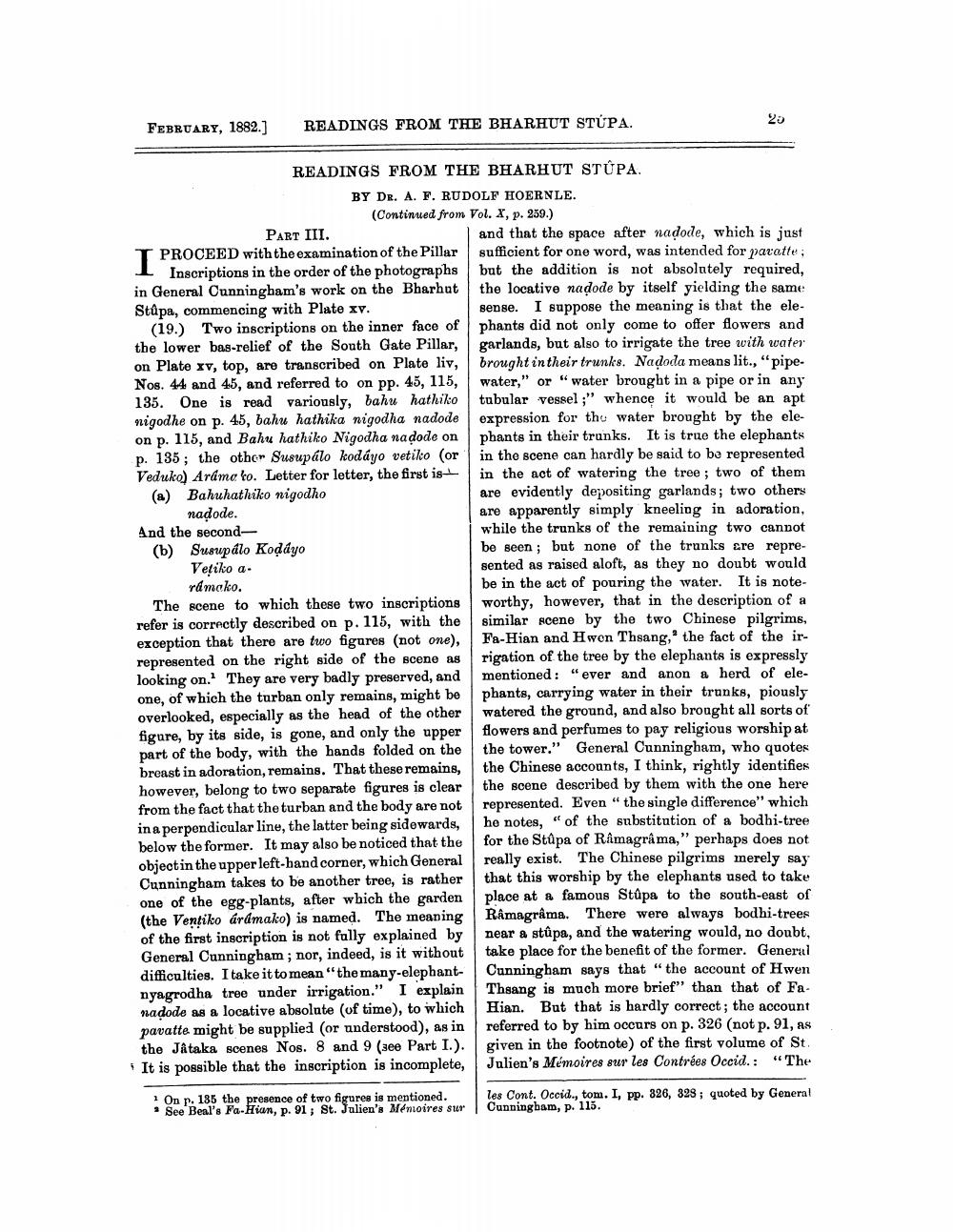________________
FEBRUARY, 1882.)
READINGS FROM THE BHARHUT STÚPA.
READINGS FROM THE BHARHUT STÚPA.
BY DR. A. F. RUDOLF HOERNLE.
(Continued from Vol. X, p. 259.) PART III.
and that the space after nadode, which is just T PROCEED with the examination of the Pillar sufficient for one word, was intended for paralle 1 Inscriptions in the order of the photographs but the addition is not absolutely required, in General Cunningham's work on the Bharhut the locative nadode by itself yielding the same Stúpa, commencing with Plate xv.
sense. I suppose the meaning is that the ele(19.) Two inscriptions on the inner face of phants did not only come to offer flowers and the lower bas-relief of the South Gate Pillar, garlands, but also to irrigate the tree with water on Plate xv, top, are transcribed on Plate liv, brought in their trunks. Nadoda means lit., "pipeNos. 44 and 45, and referred to on pp. 45, 115, water," or "water brought in a pipe or in any 135. One is read variously, bahu hathiko tubular vessel ;" whence it would be an apt nigodhe on p. 45, bahu hathika nigodha nadode expression for thu water brought by the eleon p. 115, and Bahu hathiko Nigodha nadode on phants in their trunks. It is true the elephants p. 135; the other Susupálo kodáyo vetiko (or in the scene can hardly be said to be represented Veduko) Aráme ko. Letter for letter, the first ist in the act of watering the tree; two of them (a) Bahuhathiko nigodho
are evidently depositing garlands; two others nadode.
are apparently simply kneeling in adoration, And the second
while the trunks of the remaining two cannot (b) Susupdlo Kodáyo
be seen; but none of the trunks are repreVetiko a.
sented as raised aloft, as they no doubt would rámcko.
be in the act of pouring the water. It is noteThe scene to which these two inscriptions worthy, however, that in the description of a refer is correctly described on p. 115, with the similar roene by the two Chinese pilgrims, exception that there are two figures (not one), Fa-Hian and Hwen Thsang,' the fact of the irrepresented on the right side of the scene as rigation of the tree by the elephants is expressly looking on. They are very badly preserved, and mentioned : "ever and anon a herd of eleone, of which the turban only remains, might be phants, carrying water in their trunks, piously overlooked, especially as the head of the other watered the ground, and also brought all sorts of figure, by its side, is gone, and only the upper flowers and perfumes to pay religious worship at part of the body, with the hands folded on the the tower." General Cunningham, who quotes breast in adoration, remains. That these remains, the Chinese accounts, I think, rightly identifies however, belong to two separate figures is clear the scene described by them with the one here from the fact that the turban and the body are not represented. Even " the single difference" which in a perpendicular line, the latter being sidewards, he notes, of the substitution of a bodhi-tree below the former. It may also be noticed that the for the Stupa of Râmagrâma," perhaps does not object in the upper left-hand corner, which General really exist. The Chinese pilgrims merely say Cunningham takes to be another tree, is rather that this worship by the elephants used to take one of the egg-plants, after which the garden place at a famous Stúpa to the south-east of (the Ventiko ardmako) is named. The meaning Råmagrama. There were always bodhi-trees of the first inscription is not fully explained by near a stûpa, and the watering would, no doubt, General Cunningham; nor, indeed, is it without take place for the benefit of the former. General difficulties. I take it to mean "the many-elephant- Cunningham says that "the account of Hwen nyagrodha tree under irrigation." I explainThsang is much more brief” than that of Fanadode as a locative absolute (of time), to which Hian. But that is hardly correct; the account pavatte might be supplied (or understood), as in referred to by him occurs on p. 326 (not p. 91, as the JÂ taka scenes Nos. 8 and 9 (see Part I.). given in the footnote) of the first volume of St. It is possible that the inscription is incomplete, Julien's Mémoires sur les Contrées Occid.: "The
? On p. 135 the presence of two figures is mentioned. • See Beal's Fa-Hian, p. 91 ; St. Julien's Ménioires sur
les Cont. Occid., tom. I, pp. 326, 328 ; quoted by General Cunningham, p. 115.




